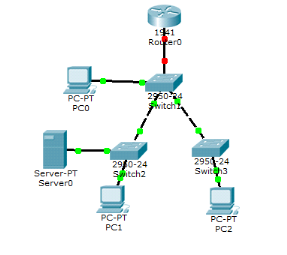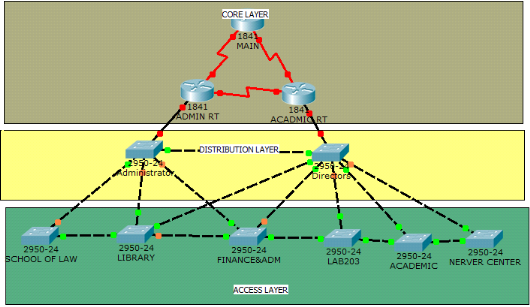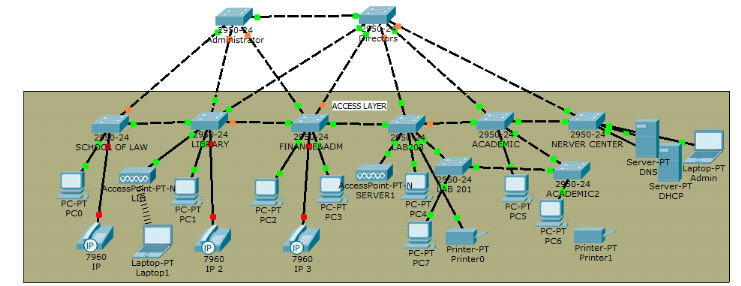2.19. 5.2.1 Flat versus Hierarchical
Topologies
2.20. 5.2.1.0 Flat network topology
A flat networktopology is adequate for small networks. With a
flat network design, there is no hierarchy. Each network device has essentially
the same job, and the network is not divided into layers or modules. A flat
network topology is easy to design and implement, and it is easy to maintain,
as long as the network stays small. When the network grows, however, a flat
network is undesirable. The lack of hierarchy makes troubleshooting difficult.
Rather than being able to concentrate troubleshooting efforts in just one area
of the network, you might need to inspect the entire network. Although mesh
networks feature good reliability, they have many disadvantages if they are not
designed carefully.

Figure 5.4: Flat network design
All the devices are on the same level, computers and
switches.
2.20.1.1. 5.2.1.1 Hierarchical Design
Model
The hierarchical design model is used to break the design up into
modular groups or layers. Breaking the design up into layers allows each layer
to focus on specific functions, which simplifies the design and provides
simplified deployment and management.
Modularity in network design allows you to create design elements
that can be replicated throughout the network. Replication provides an easy way
to scale the network as well as a consistent deployment method. In flat or
meshed network architectures, changes tend to affect a large number of systems.
Hierarchical design helps constrain operational changes to a subset of the
network, which makes it easy to manage as well as improve resiliency. Modular
structuring of the network into small, easy-to-understand elements also
facilitates resiliency via improved fault isolation.
A hierarchical design includes the following three layers:
i. Access layer: Provides workgroup/user access
to the network.
ii. Distribution layer: Aggregates access layers
and provides connectivity to services.
iii. Core layer: Provides connection between
distribution layers for large LAN environments.

Figure 5.5: Hierarchical design for JKUAT Karen
Campus
i. Access Layer
The access layer is the point at which user-controlled and
user-accessible devices are connected to the network. The access layer provides
both wired and wireless connectivity and contains features and services that
ensure security and resiliency for the entire network.
Device Connectivity
The access layer provides high-speed user-controlled and
user-accessible device connectivity. Once expensive options, high-speed access
technologies like Gigabit Ethernet and 802.11n wireless are now standard
configurations on end-user devices.

| 


